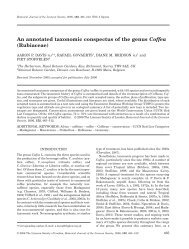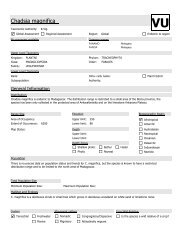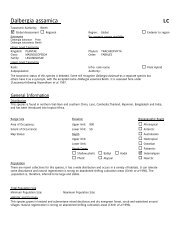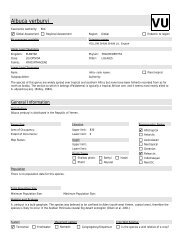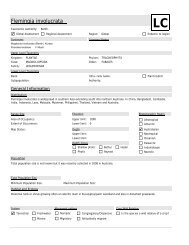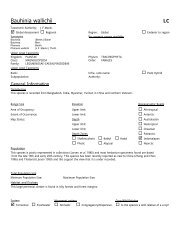Isoberlinia doka - Sampled Red List Index for Plants
Isoberlinia doka - Sampled Red List Index for Plants
Isoberlinia doka - Sampled Red List Index for Plants
Create successful ePaper yourself
Turn your PDF publications into a flip-book with our unique Google optimized e-Paper software.
<strong>Isoberlinia</strong> <strong>doka</strong>LCTaxonomic Authority:Global AssessmentCraib & StapfRegional AssessmentRegion:GlobalEndemic to regionSynonymsBerlinia <strong>doka</strong> (Craib & Stapf)Baker f.Common NamesUpper Level TaxonomyKingdom: PLANTAE Phylum: TRACHEOPHYTAClass: MAGNOLIOPSIDAOrder: FABALESFamily: LEGUMINOSAELower Level TaxonomyRank:Subpopulation:Infra- rank name:Authority: Plant HybridGeneral In<strong>for</strong>mationDistribution<strong>Isoberlinia</strong> <strong>doka</strong> is distributed in west and central Africa from Guinea in the west to Sudan and Uganda in the east (Benin,Burkina Faso, Burundi, Cameroon, Central African Rep., Chad, Ghana, Guinea, Ivory Coast, Mali, Niger, Nigeria, Sudan, Togo,Uganda and Zaire); it is not known to occur south of the equator.Range SizeArea of Occupancy:Extent of Occurrence:Map Status:PopulationElevationUpper limit:Lower limit:DepthUpper limit:Lower limit:Depth Zones Shallow photic Photic Bathyl Abyssal HadalBiogeographic Realm Afrotropical Antarctic Australasian Neotropical Oceanian Palearctic Indomalayan NearcticI. <strong>doka</strong> is widespread in west and central Africa, the species is also generally described as common and as the dominant tree ofa vegetation community (Sands 1965).Total Population SizeMinimum Population Size:Maximum Population Size:Habitat and EcologyI. <strong>doka</strong> is a tree 10-18 m high or more which grows in dry savanna. I. <strong>doka</strong> could be the dominant species in woodland savanna,which is there<strong>for</strong>e called the <strong>doka</strong> savanna (Shorrocks 2007). The species has been described as gregarious in habitat,evanescent, quickly colonising clearings and abandoned land establishing near pure stands (Burkill 1995).System Terrestrial Freshwater MarineMovement pattern Nomadic Congregatory/Dispersive Migratory Altitudinally migrantCrop Wild Relative Is the species a wild relative of a crop?
Growth FromTree - size unknowDefinitionTree (any size), also termed a Phanerophyte (>1m)ThreatsI. <strong>doka</strong> is mainly used <strong>for</strong> the timber; the species is currently common and widespread, but it would need to be monitored over along period of time to make sure that the harvested level is regulated and that the species is not over-exploited.Past Present Future13 None Conservation MeasuresThere are no known conservation measures specifically <strong>for</strong> I. <strong>doka</strong>, but the species is currently known to occur in manyprotected areas. Samples of seed of I. <strong>doka</strong> are held in the Millennium Seed Bank as an ex situ conservaions measure.In Place Needed3 Research actions 3.5 Threats 3.6 Uses and harvest levels 3.9 Trends/Monitoring 4 Habitat and site-based actions 4.4 Protected areas 4.4.3 Management 5 Species-based actions 5.3 Sustainable use 5.7 Ex situ conservation actions Countries of OccurrenceYearRoundPRESENCEPossiblyextinctExtinctPresenceuncertainNativeORIGINBreeding NonbreedingPassageSeasononly migrantseason onlyIntroduced Re- Vagrant OriginIntroduced uncertainBenin Burkina Faso Burundi Cameroon Central African Republic Chad Congo, The Democratic Republic of theCôte d'Ivoire Ghana Guinea Mali Niger Nigeria Sudan Togo Uganda General Habitats Score Description MajorImportance
General Habitats Score Description MajorImportance2 Savanna 1 SuitableUnset2.1 Savanna - Dry 1 SuitableUnsetEcosystem ServicesInsufficient In<strong>for</strong>mation availableSpecies provides no ecosystem servicesSpecies UtilisationSpecies is not utilised at allPurpose / Type of UseSubsistence National International3. Medicine - human and veterinary 7. Fuel I. <strong>doka</strong> is mainly used <strong>for</strong> the timber. In Togo the wood is reduced to ash <strong>for</strong> soap-making (Burkill 1995).Trend in the level of wild offtake/harvest in relation to total wild population numbers over the last five years:Trend in the amount of offtake/harvest produced through domestication/cultivation over the last five years:CITES status: Not listedIUCN <strong>Red</strong> <strong>List</strong>ing<strong>Red</strong> <strong>List</strong> Assessment:(using 2001 IUCN system)Least Concern (LC)<strong>Red</strong> <strong>List</strong> Criteria:Date Last Seen (only <strong>for</strong> EX, EW or Possibly EX species):Is the species Possibly Extinct? Possibly Extinct Candidate? Rationale <strong>for</strong> the <strong>Red</strong> <strong>List</strong> AssessmentI. <strong>doka</strong> is a savanna tree species common and widespread in west and central Africa. I. <strong>doka</strong> is also the dominant tree species ofthe <strong>doka</strong> savanna woodland vegetation community. At present the exploitation level doesn't seem to affect the population trendsof this species, which is described as able to colonised quickly clearings and abandoned lands.The population is believed to bestable at present and there<strong>for</strong>e the species is rated as Least Concern. The species should be monitored over a longer period oftime to make sure that it doesn't fall into a threatened category.Reason(s) <strong>for</strong> Change in <strong>Red</strong> <strong>List</strong> Category from the Previous Assessment: Genuine Change Nongenuine Change Genuine (recent) Genuine (since first assessment)Current Population Trend: Stable Date of Assessment: 02/07/2009Name(s) of the Assessor(s): Contu, S.Evaluator(s):Notes:% population decline in the past: New in<strong>for</strong>mation Knowledge of Criteria Incorrect data usedpreviously Taxonomy Criteria Revisio OtherNo ChangeSame categoryand criteriaSame category butchange in criteria
Time period over which the past decline has been measured <strong>for</strong>applying Criterion A or C1 (in years or generations):% population decline in the future:Time period over which the future decline has been measured <strong>for</strong>applying Criterion A or C1 (in years or generations):Number of Locations:Number of Mature Individuals:Severely Fragmented:BibliographyBrenan, J.P.M., 1963, The Species of <strong>Isoberlinia</strong> (Leguminosae), Kew Bulletin2, 219-226, ,Brenan,J.P.M., 1967, Caesalp.In:Flora Trop.East Africa. Milne-<strong>Red</strong>head & Polhill, , ,Burkill, H.M., 1995, The useful plants of West Tropical Africa. Volume 3, Families J–L, 857, Royal Botanic Gardens, Kew,Richmond, United KingdomSands, W.A., 1965, Termite Distribution in Man-Modified Habitats in West Africa, with Special Reference to Species Segregationin the Genus Trinervitermes (Isoptera, Termitidae, Nasutitermitinae), Journal of Animal Ecology3, 557-571, ,Shorrocks, B., 2007, The biology of African savannahs, 268, Ox<strong>for</strong>d University Press, Ox<strong>for</strong>d



